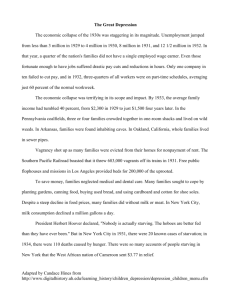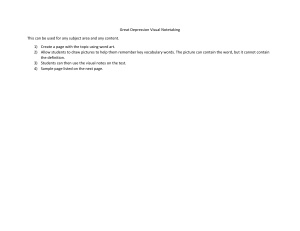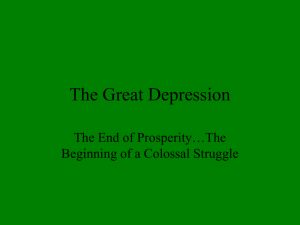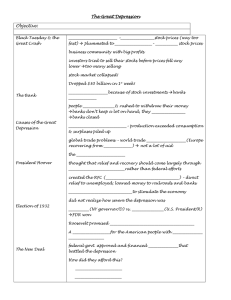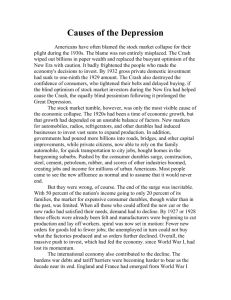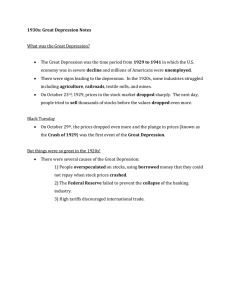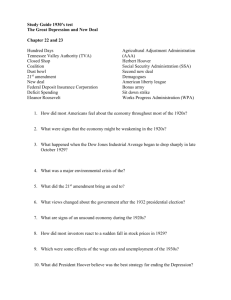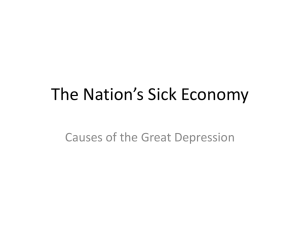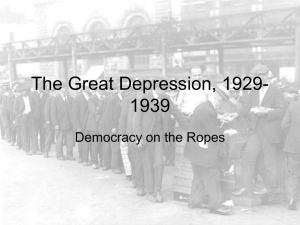The Great Depression: Causes and International Factors
advertisement
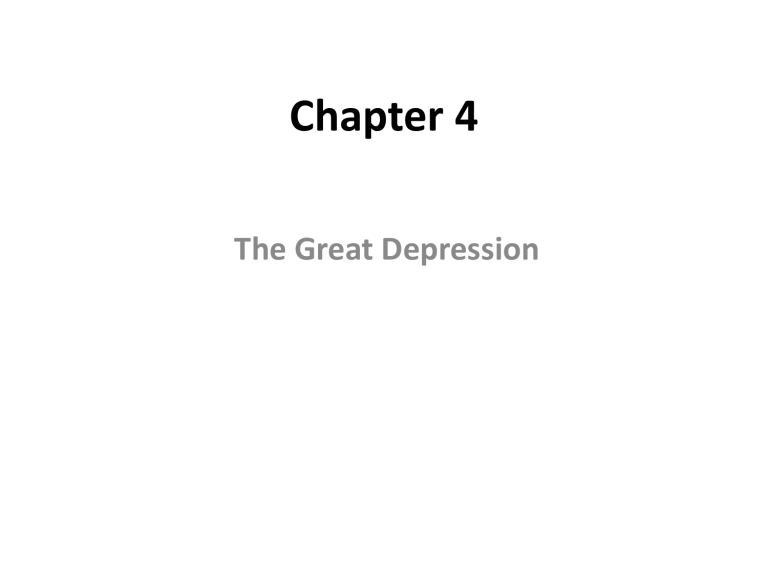
Chapter 4 The Great Depression The Great Depression The Great Depression began in the United States and rapidly spread to the rest of the world. By 1933 25% of the U.S. labour force was out of work. By 1932 industrial production in the United States was at only 55% of its 1929 level. For Germany industrial production was at 59% of the 1929 level. This does much to explain the failure of democracy in Germany and was a major cause of the Second World War. The Great Depression Just when there seemed to be signs of recovery in mid-1931 there was a financial crisis in Europe, leading to the failure of the Gold Standard. This ended any recovery and it took the Second World War to restore full employment. The Great Depression could therefore be regarded as two depressions combined – one beginning in the U.S. in 1929 and one in Europe in 1931. The Great Depression The United States and Germany were the most severely affected countries but no one escaped unscathed. In this chapter we will examine: (1) the causes of the U.S. depression; (2) why prices were not sufficiently flexible to restore employment; (3) international factors, including the causes of the international crisis of 1931. THE U.S. DEPRESSION One group of economists, including those described as “Keynesians”, emphasize non-monetary or “real” factors as the primary causes of the depression. They believe that the U.S. economy had serious structural weaknesses which made the economy extremely vulnerable to an economic shock. “Monetarist” economists (notably Milton Friedman) argue that the 1929 collapse was due to monetary factors. They believe that the U.S. economy was otherwise sound. But monetary and non-monetary explanations need not be mutually exclusive. Both monetary and non-monetary factors played a role. THE U.S. DEPRESSION The disputes between monetarist and non-monetarist economists centre on the collapse in 1929. There is general agreement that a second collapse in 1931, which reinforced that of 1929, was caused by problems in the International economy. We will now consider seven non-monetary factors. Nonmonetary Factors (1) (Income Distribution, Credit) In the decade before the Depression there was a heavy reliance on credit to sell consumer durables (e.g. cars, refrigerators) - Average real incomes rose during the 1920s but real wages hardly changed. This increased income inequality - The share of profits rose, the wage share fell. wage earners were not earning enough to buy the new consumer durables Sale on credit enabled them to buy goods but this made the economy exceptionally vulnerable to a credit squeeze, such as would result from bank failures or a stock market decline. Nonmonetary Factors (2) (Composition of Production) (2) Composition of Production. In the 1920s there was an increase in the production share of consumer durables, which were usually bought on credit. - This made the economy still more vulnerable to a collapse in credit. Nonmonetary Factors (3) (Corporate Structure) (3) There had been a change in the corporate structure. The 1920s saw a growth in holding companies and investment trusts. According to J.K. Galbraith holding companies were inclined to cut back on investments in operating companies in order to maintain dividend payments. Nonmonetary Factors (4) (Economic Theory) (4) Economic Orthodoxy. Mainstream macroeconomics between the two world wars emphasized balanced budgets – a view which created an obstacle to more vigorous policies to combat the depression. Nonmonetary Factors (5) (Agriculture) (5) A weak agricultural sector. World overproduction of primary products following the First World War resulted in low agricultural prices, especially for the Staples (such as wheat). There was a chronically weak rural economy and in the 1920s a much larger proportion of the US population depended directly or indirectly on agriculture than is the case today. Nonmonetary Factors (6) (Construction) (6) There was a decline in construction after 1925. - There was a falling birth rate and a tightening of immigration controls in the 1920s. The result was slower population growth, which led to reduced demand for new accommodations. Nonmonetary Factors (7) (A Keynesian Explanation) (7) Alvin Hansen (1939) proposed a more long term explanation. He argued that the success of the U.S. in the 19th century was due to an expanding population, which led to growth in consumption, and an expanding geographical frontier (the expansion to the west) which provided investment opportunities. Nonmonetary Factors But population growth had slowed down by the 1930s and opportunities for geographical expansion were exhausted. There was a need for increased government spending to maintain demand. - But in the 1920s government expenditure was actually being reduced, not increased. Monetary Factors (1) (Too many small banks) The monetarist view was put forward by Friedman and Schwartz in the Monetary History of the United States. They emphasized the following points: (1) There were too many small, local banks - They were vulnerable to bank runs. - These banks provided credit for stock market speculation and credit to farmers. When the stock market crashed, borrowers were unable to repay loans banks were ruined. Almost 9,000 banks failed between 1930 and 1933. Monetary Factors (2) (Mistakes of the Fed) (2) The U.S. Federal Reserve (the “Fed”) should have assisted the banks by providing them with cheap credit. It failed to do so. After 1931 the Fed actually raised interest rates to stop the outflow of gold (because of the international financial crisis of that year). Recent Explanations of the Depression We now look at some more recent explanations: (1) Credit Hypothesis (Bernanke) (2) Deflationary Expectations (Temin) (3) Stock Market Crash (Romer) Credit Hypothesis Ben Bernanke (recent head of the U.S. Federal Reserve) put forward the Credit Hypothesis. This has two main features: (1) Deflation reduced the nominal value of assets held in bank balance sheets – fear of insolvency forced them to cut back on lending – there was therefore a prolonged credit squeeze. Credit Hypothesis (2) Bank failures – banks are the major source of funds for small businesses and it requires time and effort for them to acquire information about the creditworthiness of these businesses– when banks fail this information is lost businesses find it hard to obtain credit from other banks. Deflationary Expectations Peter Temin emphasized the role of deflationary expectations – if people expect prices to continue falling they will postpone purchases. Temin believes that deflationary expectations had set in by the start of 1931, so consumption was depressed. The Stock Market Crash On “Black Thursday” (October 24, 1929) 12.9 million shares were traded ( a record at that time). On “Black Tuesday” (October 29, 1929) 16 million shares were traded. By 1932 the Dow-Jones Industrial Index had declined by 89 per cent. The Stock Market Crash The Crash reduced private wealth by about ten per cent but most economists believe this was not enough to explain the severity of the Depression. Christina Romer, however, believes that the main effect of the Crash was in generating uncertainty about future incomes. The Stock Market Crash It was this uncertainty, rather than the immediate decline in wealth, that caused consumers to cut back purchases and producers to cut back investment. Wage Rigidity An important question to ask is why, once the economic collapse had occurred, it took ten years for the Depression to end. The classical economists of the 19th century had believed that falls in demand would only have only a brief effect on output and employment because prices and wages would quickly fall to restore the economy to full employment. This had happened in earlier economic crises, such as the post-war recession of 1920-21. Wage Rigidity But by 1929 wage rigidity had appeared and wages adjusted only very slowly. Why was this so? Various explanations have been suggested, including: (1) More generous social programs made workers less willing to accept wage cuts –but such policies did not exist in the United States at that time. Wage Rigidity (2) Increased bureaucratization in large enterprises (and large unions) made frequent wage adjustments more difficult. (3) Government and business leaders had become converted to a “high wage” policy in the belief that high wages would make it possible for employees to buy goods. International Aspects We now come to the international factors which prolonged the Depression. International explanations focus on: (1) Protectionism. (2) Charles Kindleberger’s financial leadership model. (3) The role of the Gold Standard. (1) Protectionism The Depression has often been blamed on Protectionism – the Smoot-Hawley Tariff in particular. But while tariffs can result in inefficiency they would only have a significant effect on U.S. production if they prompted enough retaliation to massively reduce exports. Protectionism There was retaliation against the Smoot Hawley Tariff but U.S. exports fell by only 1.5% of GDP over the next two years – nowhere near enough to explain the Depression. (2) Kindleberger Kindleberger focused on financial leadership. In his view the international economy is inherently unstable it needs strong leadership to provide stability. The United Kingdom provided leadership before 1913 - It had a policy of free trade. As indicated in Chapter 3, British international lending was counter-cyclical. But after 1918 the United Kingdom was too financially weak to fill the leadership role. Kindleberger The United States could have provided leadership but did not do so after the First World War (though it did after the Second World War). Instead, it practiced protectionist policies. And U.S. lending was pro-cyclical. (3) The Gold Standard The weaknesses of the inter-war gold standard were described in Chapter 3. The fundamental problem was similar to the one currently facing the Eurozone, which will be discussed later. The gold standard was supposed to be symmetrical – surplus countries would adjust through inflation - deficit countries would experience deflation. The Gold Standard and the Crash of 1931 But in practice in the 1920s surplus countries “sterilized” gold flows, forcing all the adjustments on to deficit countries. Eventually, in 1931, the international financial system crashed, just as fragile signs of recovery were beginning to emerge. Financial Crisis of 1931 It shattered the fragile recovery . There was a domino effect, moving from Austria to Germany to Britain and, finally, to the United States. It began in June with Austria with the failure of the Credit-Anstallt (Austria’s largest bank). Later in June Germany felt the effects. Panic spread to German banks, which had close ties to Austria. Confidence was undermined by the coincidental collapse of the North German Wool Company. By July several banks were insolvent. The German government suspended reparations payments. Financial Crisis of 1931 In August the crisis moved to the United Kingdom. British banks had made advances to German banks. Unfortunately two damaging reports came out at the same time: (1) The Macmillan Committee reported that short-term obligations of British banks exceeded their short-term claims. (2) The May Committee reported that the government would face a budget deficit, which violated the economic orthodoxy of the time. There was an outflow of gold reserves from London. Britain forced off Gold (September). Collapse of Gold Standard (1931) This undermined confidence in the gold standard and led to a flight of gold from U.S. U.S. Federal Reserve (the “Fed”) brought in a credit squeeze to stop the outflow, which plunged the U.S. deeper into the Depression. In April 1933 the new president, Franklin D. Roosevelt suspended gold payments. This effectively ended the gold standard. Regional Currency Systems With the collapse of the Gold Standard there was no longer a single international monetary system. There were now four major currency “blocs”: (1) Sterling Area (2) Dollar Area (3) Exchange Control Area (4) Gold Bloc (until 1936) A Japanese yen bloc could also be added. Regional Currency Systems (1) Sterling Area - Used pounds sterling as an international currency. Members included: United Kingdom Commonwealth (except Canada) Several small European countries Much of the Middle East (2) Dollar Area - Used U.S. dollars as an international currency. Members included: United States Canada Latin America Regional Currency Systems (3) Exchange Control Area Used a system of exchange controls and bilateral agreements (to be described shortly). It included: Germany + Several countries in central and eastern Europe (4) Gold Bloc A few countries stayed on gold (for the time being). The main members were France and Italy. They now faced speculation as Britain and the U.S. had previously. France was forced off gold in 1936. Restrictions on Finance and Trade The 1930s saw even more more restrictions on trade and finance than the 1920s, though the end of the decade saw Some shift towards cooperation. We will now look at: (1) Exchange Controls. (2) Bilateral Agreements. (3) Trade restrictions. (4) Attempts at international agreements. (1) Exchange Controls With exchange controls foreign currency transactions are controlled by the central bank or a government agency. The obvious disadvantage is that this distorts trade patterns Exchange Controls But in the context of the 1930s exchange controls had three advantages: (1) They prevented foreign exchange crises. (2) They enabled governments to pursue expansionary domestic policies without having to worry about the flight of financial capital. (3) They allowed artificially high exchange rates which alleviated any fears of inflation and reduced foreign debt service costs. (2) Bilateral Agreements Several countries entered bilateral agreements, of which there were three main kinds: (1) Compensation agreements – these were effectively barter agreements. (2) Clearing agreements. - Each country in a bilateral clearing agreement would maintain a bank account in the other country. - It could use funds in this account only to buy the other country’s goods. Bilateral Agreements Germany organized the Exchange Control Area which utilized a system of clearing agreements. It was known as the Schacht System after the Nazi Minister of Economy (and former Currency Commissioner), Hjalmar Schacht. Bilateral Agreements (3) Payments agreements were another attempt at international cooperation. - They covered not just trade in goods but also types of financial transactions, e.g. debt repayments. -The only important payments agreement at this time was the Anglo-German Agreement of 1934. (3) Trade Restrictions Most countries did not have exchange controls but there was an increase in other kinds of trade barriers. Examples are: Smoot-Hawley Tariff (1930) – in U.S. Import Duties Act (1932) – in U.K. There was also an expanded use of import quotas, i.e. quantitative restrictions. (4) Attempts at Cooperation There were few attempts at cooperation but there were some: (1) The Bank for International Settlements (BIS) was created to manage German reparations payments and promote cooperation between central banks. It still performs the second of these functions. (2) The Tripartite Monetary Agreement between France, United Kingdom, United States was signed in 1936. It did not get far because of the Second World War but it was a precursor to the Bretton Woods Agreement. (3) The Ottawa Agreement (1932) set up a system of tariff concessions between Commonwealth countries which continued until 1973. (4) Commercial companies set up cartels to divide up the world market.
